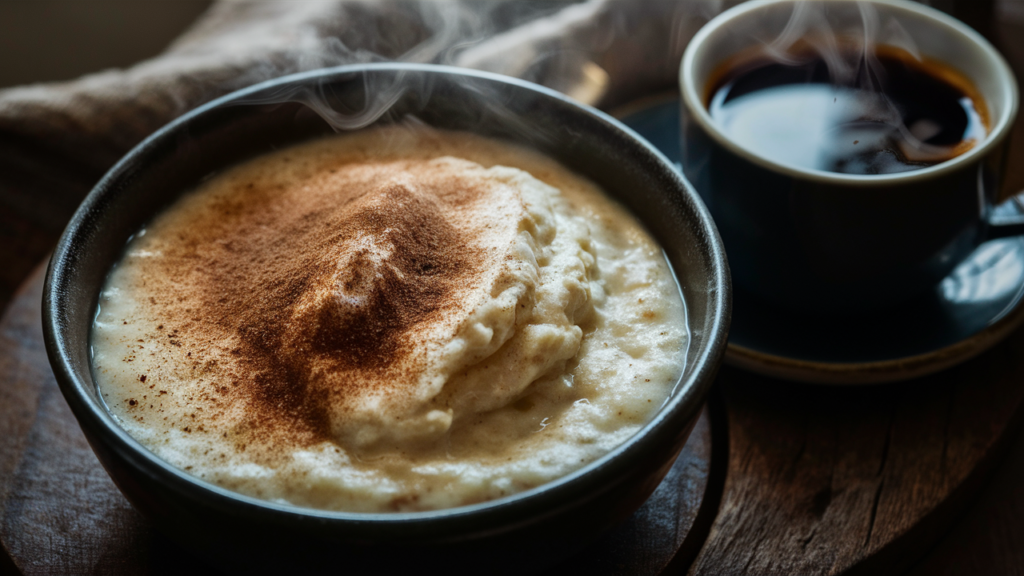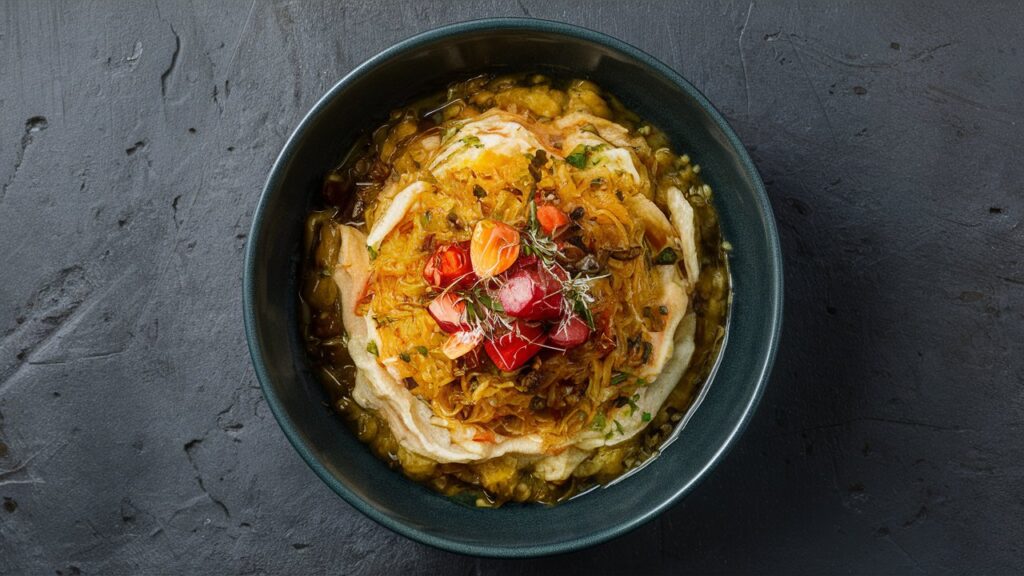Rommegrot is a traditional Norwegian porridge made primarily from sour cream, flour, and milk. It’s a rich, comforting dish typically served during special occasions such as Norwegian Constitution Day and other celebrations. This creamy dish not only offers a taste of Norwegian culture but also provides an opportunity to explore the intricacies of one of Scandinavia’s beloved culinary staples. In this comprehensive guide, we’ll walk through everything you need to know to prepare authentic Rommegrot recipe”, along with tips and variations to enhance your cooking experience.
Introduction to Rommegrot recipe”
What is Rommegrot?
Rommegrot, often spelled “rømmegrøt“, is a warm, thick porridge celebrated for its creamy texture and rich flavor. It is made by slowly cooking sour cream, flour, and milk to create a hearty dish often topped with melted butter, cinnamon, and sugar.
- Cultural Significance: Rommegrot has a storied history in Norway, typically associated with holidays and family gatherings.
- Ingredients: The key components include sour cream, whole milk, and all-purpose flour.
- Serving Traditions: Often enjoyed with cured meats and flatbread on the side.
Nutritional Information
While Rommegrot is undoubtedly indulgent, it also offers nutritional benefits that can be adjusted depending on the ingredients used:
- Calories: Primarily from fats due to the sour cream and butter, providing energy.
- Carbohydrates: From flour, which helps to make the dish filling.
- Adjustments: For a lighter version, some opt to use low-fat milk or a smaller amount of sour cream.
Variations of Rommegrot recipe
Though traditional Rommegrot is beloved, many enjoy experimenting with variations to suit different tastes and dietary needs:
- Gluten-Free: Using cornstarch or a gluten-free flour blend instead of regular flour.
- Vegan: Substituting vegan cream and plant-based milk.
- Additional Flavors: Incorporating cardamom or vanilla for a different taste profile.
Exploring the basic aspects of Rommegrot sets the foundation for anyone looking to dive into this delicious part of Norwegian cuisine.
Classic Rommegrot Recipe
Ingredients List
To make traditional Rommegrot recipe, you will need the following ingredients:
- Sour Cream: 2 cups (full-fat for authenticity)
- Whole Milk: 2 cups, plus additional for thinning the porridge if necessary
- All-Purpose Flour: 1/2 cup
- Salt: A pinch to enhance flavor
- For Serving: Melted butter, sugar, and cinnamon
Step-by-Step Cooking Process
Creating the perfect batch of Rommegrot recipe involves careful attention to detail during the cooking process:
- Heat the Sour Cream: Start by slowly heating the sour cream in a heavy-bottomed saucepan until it warms up and starts to simmer.
- Mix in Flour: Gradually whisk in the flour, ensuring no lumps form.
- Add Milk: Slowly add the milk while stirring continuously until the mixture thickens to a porridge-like consistency.
- Cooking Time: Let the mixture simmer for about 15 minutes, stirring frequently to prevent sticking and burning.
Tips for Perfect Rommegrot recipe
Achieving the ideal texture and flavor in Rommegrot can be challenging for beginners, but these tips can help:
- Consistent Stirring: This is crucial to prevent lumps and ensure a smooth texture.
- Heat Control: Maintain a low heat to avoid burning the cream.
- Quality Ingredients: Use high-quality sour cream and fresh milk for the best taste.
This basic recipe serves as a starting point for anyone new to making Rommegrot, providing a simple yet satisfying experience.

Serving and Enjoying Rommegrot recipe
Traditional Toppings and Sides
Rommegrot is typically enjoyed with a variety of toppings and side dishes that complement its rich flavor:
- Toppings: A generous dollop of melted butter, a sprinkle of sugar, and a dash of cinnamon are traditional.
- Sides: Serve with dried meats like fenalår (dried and cured lamb) or spekemat (a variety of cured meats), along with crusty bread or flatbread.
Modern Serving Suggestions
To keep the tradition alive while catering to modern tastes, consider these serving ideas:
- Fruit Compotes: Offer a refreshing contrast with a berry compote.
- Savory Options: Some might enjoy a savory version with crisp bacon bits or green onions.
- Dessert Style: Serve as a dessert with a drizzle of honey or maple syrup and a side of fresh berries for a sweet treat.
**Storing and Reheating Leftovers
**
Proper storage and reheating are important to maintain the quality of Rommegrot:
- Storage: Keep in an airtight container in the refrigerator for up to three days.
- Reheating: Gently reheat on the stove, adding a little milk to thin it if necessary. Stir continuously to avoid any changes in texture.
Understanding how to serve and store Rommegrot ensures that every batch is as enjoyable as the first, whether you’re savoring it fresh or the following day.
Advanced Rommegrot recipe Variations and International Influence

Incorporating Global Flavors
While Rommegrot is distinctly Norwegian, integrating elements from other cuisines can give it an intriguing twist:
- Spices: Introduce spices such as nutmeg or clove for a warm, aromatic flavor.
- International Toppings: Top with ingredients like coconut flakes, almonds, or even saffron for a luxurious touch.
Rommegrot in Fusion Cuisine
As global culinary landscapes merge, Rommegrot finds its way into fusion dishes:
- Dessert Creations: Imagine a Rommegrot-based tart filling or as a component in layered desserts.
- Savory Innovations: Utilize Rommegrot as a base for savory toppings, similar to polenta, creating a unique Norwegian-inspired entrée.
Hosting a Rommegrot-Themed Dinner Party
Organize a dinner party that showcases Rommegrot in various forms, from the starter to the dessert:
- Menu Planning: Include traditional dishes as well as your unique creations.
- Decor and Ambiance: Decorate with Norwegian-inspired themes to enhance the cultural experience.
- Educational Element: Share the history and significance of Rommegrot with your guests to deepen their appreciation for the meal.
By exploring and experimenting with Rommegrot, you can enjoy this traditional Norwegian dish in new and exciting ways, making it adaptable to contemporary tastes while honoring its rich heritage. Whether you stick to the traditional recipe or try out new variations, Rommegrot offers a delightful glimpse into Norway’s culinary traditions.
Health Considerations and Dietary Adaptations of Rommegrot recipe
Making Rommegrot Healthier
Rommegrot is traditionally rich in fats and carbohydrates, which might not suit everyone’s dietary needs. Here are ways to adjust the recipe for a healthier version:
- Low-Fat Options: Substitute the full-fat sour cream with a lower-fat version or use a mixture of light sour cream and Greek yogurt to reduce the overall fat content without compromising too much on texture.
- Whole Grain Alternatives: Replace all-purpose flour with whole grain flour such as oat flour or whole wheat flour to add fiber and nutrients.
- Sugar Substitutes: For those watching their sugar intake, consider using natural sweeteners like stevia or monk fruit as alternatives to conventional sugar.
Gluten-Free and Lactose-Free Versions
For those with specific dietary restrictions, making Rommegrot gluten-free and lactose-free is simpler than it might seem:
- Gluten-Free Flour: Use gluten-free flour blends available in the market or a single type like rice flour or almond flour as a thickener instead of regular flour.
- Lactose-Free Dairy: Opt for lactose-free sour cream and milk to make a version that is easier on the stomach for those with lactose intolerance.
Vegan Rommegrot
Creating a vegan version of Rommegrot allows those following a vegan diet to enjoy this traditional dish:
- Vegan Cream: Use coconut cream or a soy-based cream as a substitute for sour cream.
- Plant-Based Milk: Replace regular milk with almond, soy, or oat milk according to preference.
- Additional Flavorings: To mimic the rich dairy flavor, consider adding nutritional yeast or a vegan butter alternative for added depth.

Pairing Rommegrot recipe with Beverages
Traditional Norwegian Drinks
Pairing Rommegrot with traditional Norwegian beverages can enhance the dining experience. Here are some beverages that complement the richness of Rommegrot:
- Akevitt (Aquavit): This distilled spirit is a classic Norwegian drink that pairs well with creamy dishes like Rommegrot.
- Hot Coffee: A strong, hot coffee balances the sweetness and creaminess of Rommegrot, making it a perfect pairing especially during cold weather.
Non-Alcoholic Options
For those preferring non-alcoholic beverages, there are suitable options that still complement the dish:
- Spiced Apple Cider: The spices and sweetness of apple cider make it a great match for the richness of Rommegrot, especially during autumn and winter.
- Herbal Teas: Chamomile or peppermint tea can provide a refreshing counterbalance to the heaviness of the dish.
International Wine Pairings
While not traditional, pairing Rommegrot with wine can appeal to the international palate:
- Dessert Wines: A sweet dessert wine like Sauternes or a German Riesling complements the creamy texture and sweet toppings of Rommegrot.
- Sparkling Wines: A light sparkling wine can cut through the richness and refresh the palate between bites.
Rommegrot in Culinary Education and Cultural Exchange
Teaching Traditional Recipes
Incorporating Rommegrot into culinary education can help preserve and spread Norwegian culinary traditions:
- Cooking Classes: Offer classes focused on Scandinavian cuisine where participants can learn how to make Rommegrot along with other Norwegian dishes.
- Recipe Books: Include Rommegrot in cookbooks that explore traditional dishes from around the world.
Cultural Exchange Programs
Using Rommegrot as a tool for cultural exchange can enhance understanding and appreciation between different cultures:
- International Food Fairs: Showcase Rommegrot at food fairs as part of Norwegian cuisine to introduce it to a wider audience.
- Exchange with Other Cuisines: Collaborate with culinary experts from other countries to create fusion dishes that incorporate elements of Rommegrot, showcasing how traditional dishes can adapt and evolve through cultural exchange.
Online Platforms and Social Media
Leveraging online platforms can aid in bringing Rommegrot to a global audience:
- Cooking Blogs and Videos: Share recipes and cooking videos online to reach people interested in trying new foods.
- Social Media Challenges: Engage users by creating challenges or contests to come up with innovative recipes using Rommegrot as a base.
Through these efforts, Rommegrot can transcend its traditional roots and become a part of global cuisine, appreciated not only for its taste but also for its cultural significance. This journey through the world of Rommegrot showcases its versatility from a humble Norwegian dish to a component of global culinary heritage, offering myriad possibilities for chefs, home cooks, and food enthusiasts around the world.
You can get more recipes from here:

